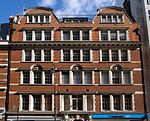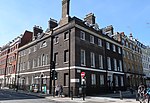Victoria House, London
1932 architectureBuildings and structures in BloomsburyGrade II listed buildings in the London Borough of Camden

Victoria House is a neoclassical building in Bloomsbury, London, WC1. It stands on a long rectangular island site between the east side of Bloomsbury Square and Southampton Row. It became a Grade II listed building in December 1990.
Excerpt from the Wikipedia article Victoria House, London (License: CC BY-SA 3.0, Authors, Images).Victoria House, London
Southampton Row, London Holborn (London Borough of Camden)
Geographical coordinates (GPS) Address External links Nearby Places Show on map
Geographical coordinates (GPS)
| Latitude | Longitude |
|---|---|
| N 51.5193 ° | E -0.1221 ° |
Address
Southampton Row 37-63
WC1B 4DA London, Holborn (London Borough of Camden)
England, United Kingdom
Open on Google Maps











